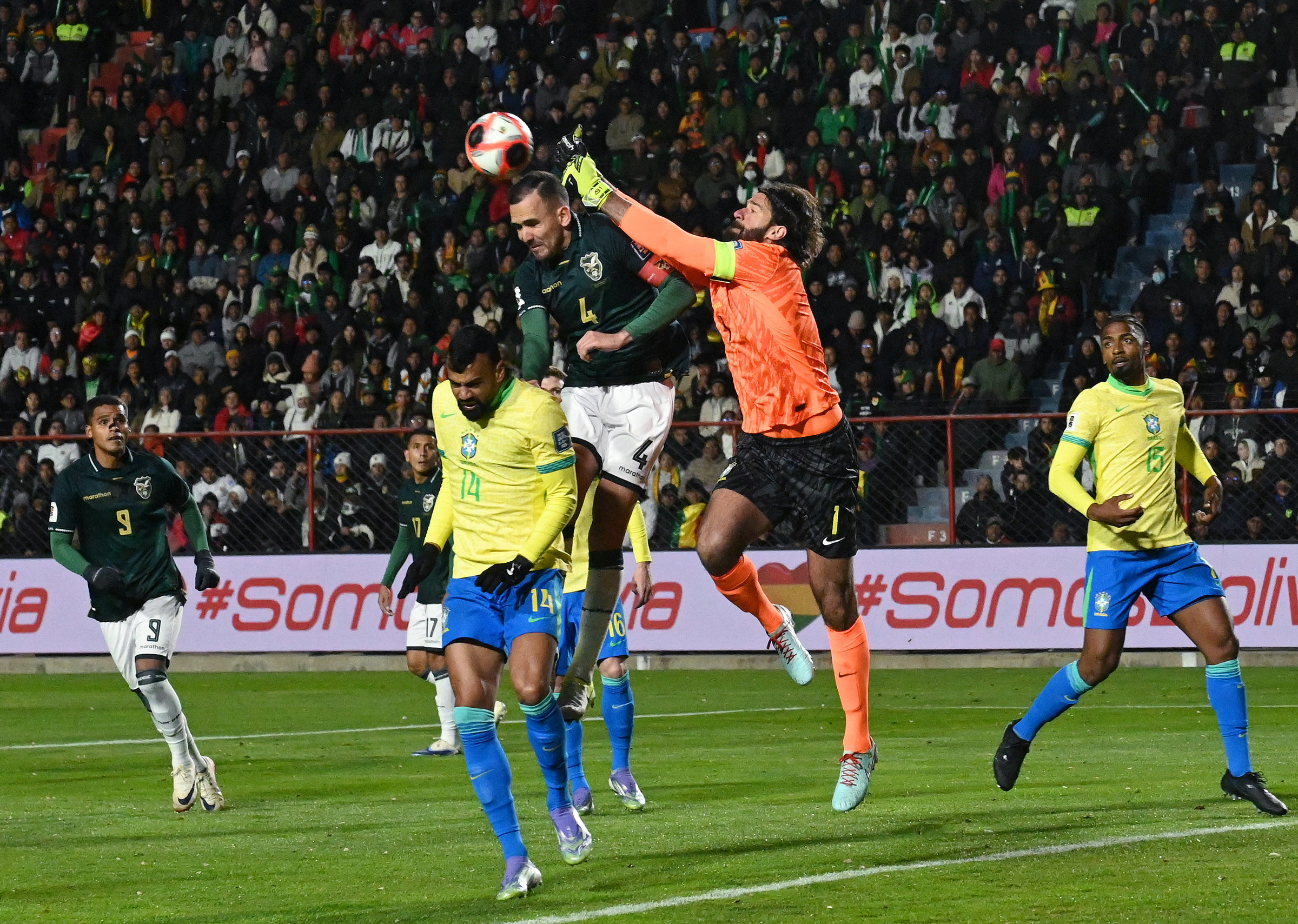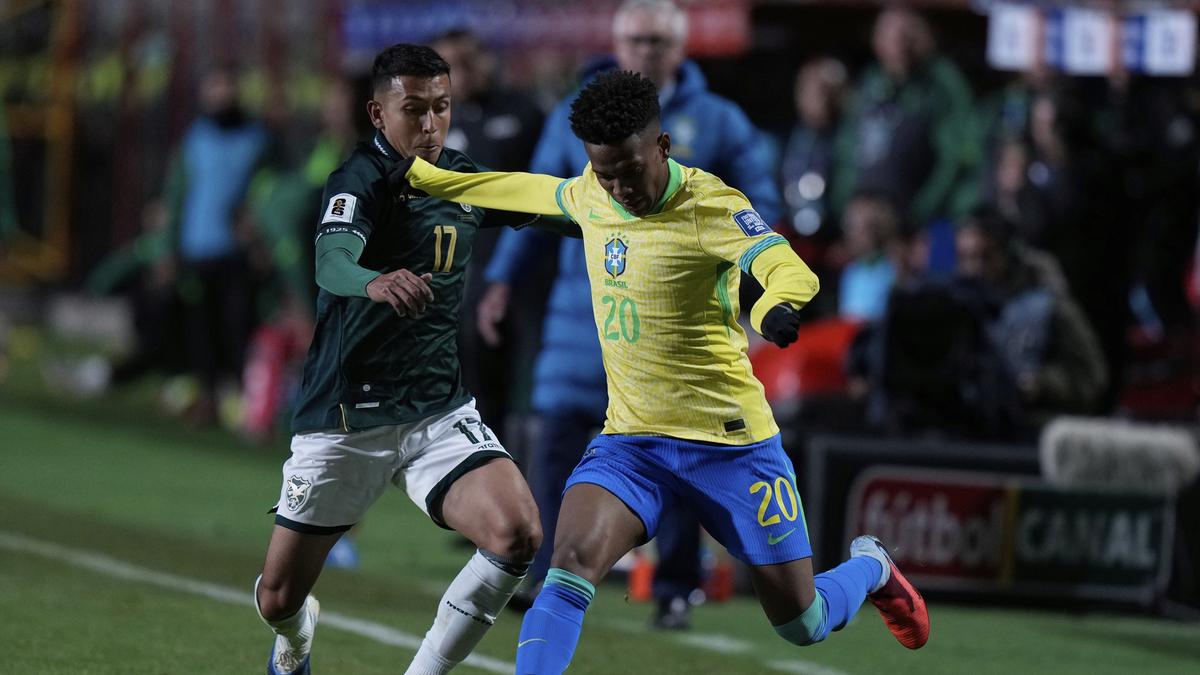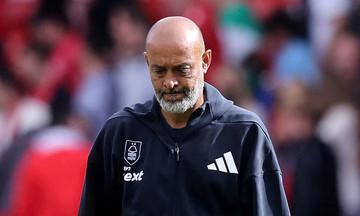CONMEBOL (South American Football Confederation) concluded its World Cup qualifying campaign on 9/9/2025, which began in September 2023. With six direct qualification spots available, the teams heading to North America next summer were already determined before the final matches: Argentina, Brazil, Uruguay, Ecuador, Colombia, and Paraguay.
While Argentina maintained their top position despite losing to Ecuador, and Paraguay held onto the sixth spot, the other qualifying positions shifted. Ecuador and Colombia each moved up two places, securing the second and third spots respectively. Uruguay and Brazil dropped to fourth and fifth place.
 |
Goalkeeper Alisson Becker catches the ball during Brazil's 1-0 defeat to Bolivia in El Alto, La Paz, Bolivia on 9/9/2025. Photo: Reuters |
Goalkeeper Alisson Becker catches the ball during Brazil's 1-0 defeat to Bolivia in El Alto, La Paz, Bolivia on 9/9/2025. Photo: Reuters
Brazil will set a record by participating in all 23 World Cups, and will still be a seeded team due to their FIFA top 10 ranking. However, this campaign marks their poorest qualifying performance to date. They finished fifth with 28 points and a 51% win rate. Since 1996, when the 10-team format for South American qualifiers was introduced, Brazil has never earned fewer than 30 points. Thanks to CONMEBOL's six direct qualification spots, Brazil avoided the intercontinental playoffs required under the previous format.
The seventh-place spot in the South American qualifiers, offering a chance at a playoff berth, was held by Venezuela before the final round but now belongs to Bolivia. Their 1-0 victory over Brazil, leveraging their home advantage in the high-altitude city of El Alto (4,150 meters above sea level), gives Bolivia a chance to return to the World Cup after 32 years, their last appearance being in the USA in 1994. In that qualifying campaign, Bolivia also defeated Brazil in La Paz (3,640 meters above sea level) to secure direct qualification.
In the intercontinental playoffs, Bolivia will compete against two teams from CONCACAF, one from AFC, one from CAF, and one from OFC for the two remaining World Cup spots. This playoff round will be divided into two brackets, from semi-finals to finals. The four lowest-ranked teams based on FIFA rankings will compete in the semi-finals, with the remaining two teams advancing directly to the finals. The playoffs will take place in March next year in North America.
Chile is the most notable team eliminated from South America. The 2015 and 2016 Copa America champions finished last, missing their third consecutive World Cup. In contrast, Paraguay returns to the tournament for the first time since South Africa in 2010.
Along with the three host nations – the USA, Canada, and Mexico – 15 other teams have secured their places in the 2026 World Cup.
In addition to the three automatic host nation spots, the North, Central American, and Caribbean region (CONCACAF) has three more direct qualification spots. The remaining CONCACAF representatives for the World Cup will be determined in November.
Europe, with the most competing teams (54) and the most World Cup spots (16), will conclude its qualifying campaign at the end of March next year. No European teams have yet qualified.
Africa, allocated 9 World Cup spots by FIFA, will complete its qualifying stage in mid-November. Morocco and Tunisia have already secured their places due to significant point advantages in their respective groups.
Similarly, although Asian (AFC) qualifiers continue until November, six teams have already qualified: Australia, Iran, Japan, Jordan, South Korea, and Uzbekistan. Jordan and Uzbekistan will be making their World Cup debuts.
Oceania (OFC), which concluded its qualifiers in late March, has determined its sole direct qualifier: New Zealand. New Zealand's two previous World Cup appearances, in 1982 and 2010, were both secured through intercontinental playoffs. This year, the "All Whites" qualified directly, thanks to FIFA allocating a direct spot to OFC for the first time.
18 qualified teams for the 2026 World Cup:
Asia (6 teams): Australia, Iran, Japan, Jordan, South Korea, and Uzbekistan.
Africa (2 teams): Morocco and Tunisia.
North, Central America, and Caribbean (3 host nations): USA, Canada, and Mexico.
South America (6 teams): Argentina, Ecuador, Colombia, Uruguay, Brazil, and Paraguay.
Oceania (1 team): New Zealand.
Hoang Thong
As of 9/9, 18 teams have qualified for the 2026 World Cup: USA, Canada, Mexico (host nations), Iran, Uzbekistan, South Korea, Jordan, Japan, Australia, New Zealand, Argentina, Ecuador, Brazil, Uruguay, Colombia, Paraguay, Morocco, and Tunisia.
 |
Brazil's Estavao competes for the ball with a Bolivian player during their 1-0 loss on 9/9. Photo: AP |
Brazil's Estavao competes for the ball with a Bolivian player during their 1-0 loss on 9/9. Photo: AP
The matches on 9/9 also confirmed Bolivia's playoff spot as the seventh-placed team in the South American qualifiers. Bolivia's unexpected 1-0 victory over Brazil gave them 20 points, pushing Venezuela (18 points) down to eighth. In another match, Venezuela lost 6-3 to Colombia despite leading twice.
Six teams will compete for two playoff spots: Bolivia, the runner-up from Oceania's qualifiers, the winner of Asia's fifth-place playoff, the winner of Africa's second-place playoff, and the two best second-placed teams from CONCACAF's third round of qualifying. FIFA will select two seeded teams to advance directly to the final round. The remaining four teams will be paired to compete for the other two spots in the finals.
The 2026 World Cup will feature a record 48 teams, an increase of 16 from the 2022 World Cup. The allocation is as follows: Europe (16), Africa (9), Asia (8), South America (6), CONCACAF (6, including three host nations and three qualifiers), Oceania (1), and two playoff spots.
Thanh Quy












